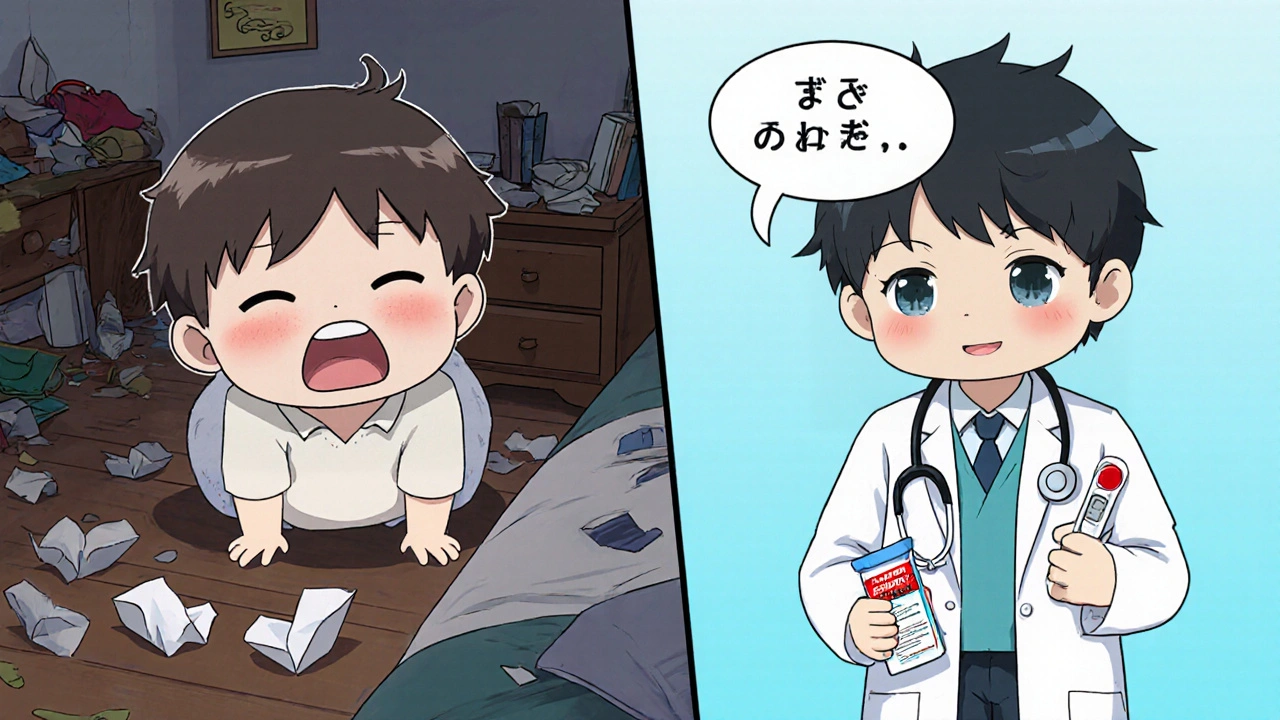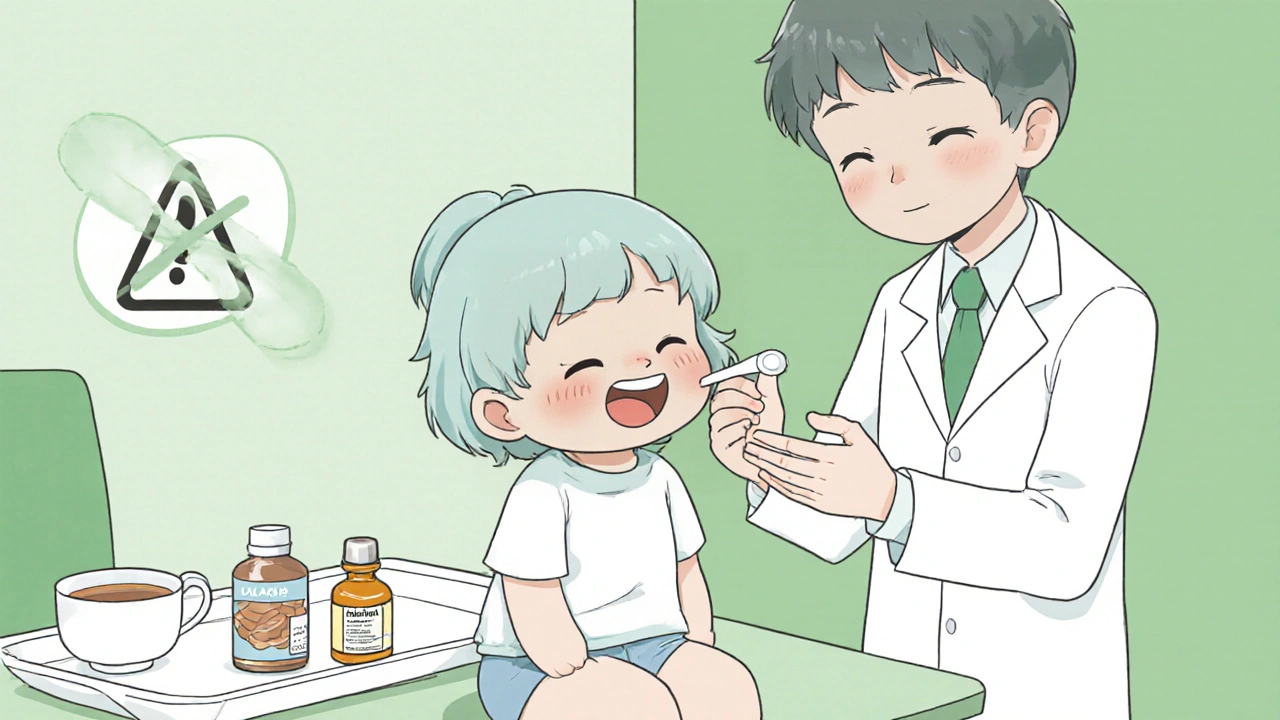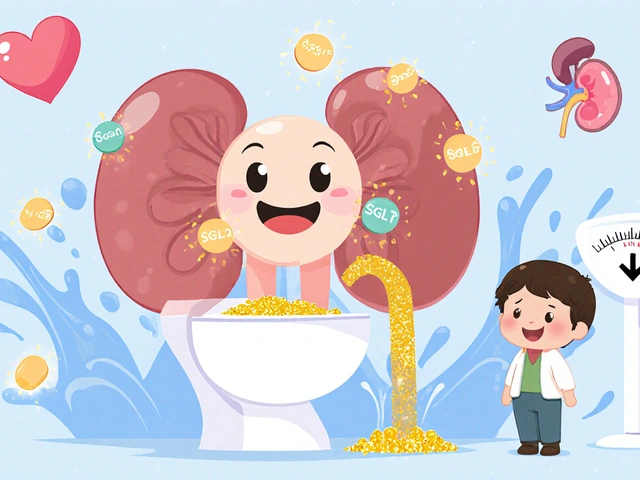Tonsillitis Symptom Checker
This tool helps you assess your tonsillitis symptoms and determine if you should seek medical attention. Based on guidelines from the article, select any symptoms you're experiencing to get guidance on next steps.
No urgent symptoms detected. You can likely manage this at home with rest, hydration, and OTC pain relief.
However, if symptoms worsen or don't improve within 3-5 days, please consult a healthcare professional.
You may have symptoms that require medical attention. Consult with a healthcare provider to determine if antibiotics are needed.
Consider calling your doctor for evaluation, especially if you have multiple symptoms.
You should seek medical attention immediately.
These symptoms indicate a potentially serious infection that requires prompt medical evaluation and treatment.
Important: This tool is for informational purposes only and does not replace professional medical advice. If you're experiencing severe symptoms, please call your doctor or visit an urgent care facility immediately.
Got a sore throat that just won’t quit? You might be dealing with tonsillitis, but the real question is: when should you call your doctor? This guide breaks down the red‑flag signs, explains why they matter, and tells you exactly what steps to take so you can get back to feeling normal fast.
What is Tonsillitis?
Tonsillitis is an inflammation of the two lymphoid tissues at the back of the throat, called the tonsils. They act as a first line of defense against germs that enter through the mouth or nose. When they get infected, they swell, turn red, and can become painful.
Common Causes and How They Differ
The most frequent culprits are viruses-think the same ones that cause the common cold. However, a bacterial infection called Strep throat (caused by Group A Streptococcus, or GABHS) can also trigger tonsillitis. Distinguishing between viral and bacterial origins matters because only bacterial cases need antibiotics.
Typical Symptoms You Can Manage at Home
- Sore throat that feels worse when swallowing
- Red, swollen tonsils-sometimes with white patches
- Fever up to 101°F (38.3°C)
- Headache, earache, or mild neck pain
- General fatigue and loss of appetite
For most of these, rest, hydration, and over‑the‑counter pain relievers like acetaminophen or ibuprofen usually do the trick. If you’re seeing these signs without any alarming changes, home care is usually enough.
Red‑Flag Signs: When to Seek Medical Help
Not all sore throats are equal. Keep an eye out for any of the following; they’re signals that the infection might be getting serious or turning bacterial:
| Urgent (Call Doctor) | Can Monitor at Home |
|---|---|
| Difficulty breathing or swallowing | Mild sore throat |
| Severe neck swelling or drooling | Low‑grade fever (<100°F) |
| Sudden, high fever (above 103°F/39.4°C) | Headache that improves with rest |
| Vision changes, ear pain that won’t subside | Loss of appetite but still drinking fluids |
| White patches that spread quickly or pus‑filled spots | Occasional cough |
| Symptoms lasting more than 10days without improvement | Minor fatigue |
If any of these urgent signs appear, it’s time to see a clinician. Delaying care can lead to complications like a Peritonsillar abscess, a painful pocket of pus that sits next to the tonsil and may block the airway.

Why Prompt Treatment Matters
When tonsillitis is caused by Strep throat, antibiotics such as penicillin or amoxicillin are prescribed to eradicate the bacteria. Starting antibiotics within 9 days of symptom onset cuts the risk of two serious sequelae:
- Rheumatic fever - an inflammatory disease that can damage heart valves.
- Post‑streptococcal glomerulonephritis - a kidney inflammation that can cause blood in the urine.
Both complications are rare but preventable with timely treatment.
How a Doctor Diagnoses Tonsillitis
During the visit, the clinician will look for classic signs and may do a rapid antigen detection test (RADT) to confirm strep bacteria. If the RADT is negative but suspicion remains high, a throat culture (taking 24‑48hours) could be ordered.
Blood work isn’t usually needed unless there’s a concern for a systemic infection or complications.
Treatment Options: What to Expect
- Antibiotics - Only for confirmed bacterial cases. Finish the full course, even if you feel better after a few days.
- Pain management - Acetaminophen or ibuprofen every 4‑6hours, as directed.
- Hydration - Warm soups, herbal teas, and plenty of water keep the throat moist.
- Home remedies - Gargling with salt water (½tsp salt in 8oz warm water) three times daily can reduce swelling.
- Follow‑up - If symptoms persist beyond 48hours after starting antibiotics, a second visit is warranted.
In rare chronic cases, an ENT specialist may discuss tonsillectomy, especially if infections recur more than seven times a year.

When to Call an Emergency Service
Any sign that the airway is compromised demands immediate attention. Watch for:
- Stridor - a high‑pitched breathing sound.
- Severe drooling or inability to swallow saliva.
- Blue‑tinged lips or skin.
- Sudden collapse or extreme confusion.
Dial 911 or head straight to the nearest emergency department if these appear.
Quick Checklist for Parents
- Check temperature twice a day.
- Count how many days the sore throat has lasted.
- Look for swelling around the neck or under the jaw.
- Ask your child if swallowing feels painful or if they drool more than usual.
- Contact your pediatrician if any red‑flag signs show up.
Kids often hide discomfort, so trust your gut - you know their normal behavior best.
Bottom Line
Most tonsillitis cases are viral and improve with rest and fluids. However, the moment you see breathing trouble, high‑grade fever, or symptoms that linger beyond a week, it’s time to seek professional care. Prompt treatment, especially for bacterial infections, can prevent rare but serious complications.
Frequently Asked Questions
Can I treat strep tonsillitis without antibiotics?
No. Strep tonsillitis is a bacterial infection, and antibiotics are needed to clear the bacteria, reduce symptom duration, and avoid complications like rheumatic fever.
How long does viral tonsillitis usually last?
Typical viral tonsillitis improves within 5‑7days with rest, hydration, and pain relievers. If it drags on longer, see a clinician.
What is a peritonsillar abscess and why is it dangerous?
It’s a collection of pus that forms next to a tonsil, often after untreated bacterial tonsillitis. It can push the airway closed, cause severe pain, and spread infection to nearby tissues, so it requires prompt drainage and antibiotics.
Do over‑the‑counter lozenges help?
They can provide temporary soothing, but they don’t treat the underlying infection. Use them alongside rest, fluids, and pain relievers.
When is tonsil removal recommended?
Surgery is considered if a person has more than seven sore throat episodes a year, chronic peritonsillar abscesses, or breathing problems from enlarged tonsils.




Sounds like a pain, dude.
I kinda feel ya when you say the throat just won’t let up, it's like your voice got stuck in a rainy day.
But all that swelling? It’s the body's way of sending a stubborn postcard. Maybe sip some warm tea and let the immune squad do its thing.
They don’t want you to think it’s just a sore throat; it’s a test, a trial orchestrated by deep‑state health agencies to push their vaccine agendas.
Every sneeze is a data point, every white patch a barcode. Stay vigilant, check your water, and consider the hidden motives behind every "red‑flag" they list.
Look, if you’re having trouble swollwing and breathing, don’t wait for the doc. Just gove yourself some ibuprofen, a liqour of honey, and maybe a little rest. BTW your throat is probably just bored.